This document provides an introduction and overview of the Python programming language. It describes Python as a general-purpose, object-oriented programming language with features like high-level programming capabilities, an easily understandable syntax, portability, and being easy to learn. It then discusses Python's characteristics like being an interpreted language, supporting object-oriented programming, being interactive and easy to use, having straightforward syntax, being portable, extendable, and scalable. The document also outlines some common uses of Python like for creating web and desktop applications, and provides examples of using Python's interactive and script modes.

























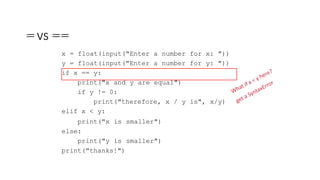










![STRINGS
6.0001 LECTURE3 37
square brackets used to perform indexing into a string
to get the value at a certain index/position
s = "abc"
s[0] evaluates to "a"
s[1] evaluates to "b"
s[2] evaluates to "c"
s[3] trying to index out of bounds, error
s[-1] evaluates to "c"
s[-2] evaluates to "b"
s[-3] evaluates to "a"
index:
index:
0 1 2 indexing always starts at 0
-3 -2 -1 last element always at index -1](https://image.slidesharecdn.com/introductiontopython-221004055743-c8cbd0da/85/Introduction-To-Python-pptx-37-320.jpg)
![STRINGS
strings are “immutable” – cannot be modified
s = "hello"
s[0] = 'y'
s = 'y'+s[1:len(s)]
gives an error
is allowed,
s bound to new object
s
"hello"
"yello"
6.0001 LECTURE3 38](https://image.slidesharecdn.com/introductiontopython-221004055743-c8cbd0da/85/Introduction-To-Python-pptx-38-320.jpg)
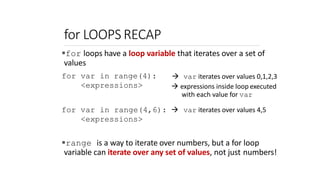
![STRINGS AND LOOPS
6.0001 LECTURE3 40
these two code snippets do the same thing
bottom one is more “pythonic”
s = "abcdefgh"
for index in range(len(s)):
if s[index] == 'i' or s[index] == 'u':
print("There is an i or u")
for char in s:
if char == 'i' or char
print("There is an
== 'u':
i or u")](https://image.slidesharecdn.com/introductiontopython-221004055743-c8cbd0da/85/Introduction-To-Python-pptx-40-320.jpg)
![CODE EXAMPLE:
ROBOT CHEERLEADERS
an_letters = "aefhilmnorsxAEFHILMNORSX"
word = input("I will cheer for you! Enter a word: ")
times = int(input("Enthusiasm level (1-10): "))
i = 0
while i < len(word):
char = word[i]
if char in an_letters:
print("Give me an " + char + "! " + char)
else:
print("Give me a " + char + "! " + char)
i += 1
print("What does that spell?")
for i in range(times):
print(word, "!!!")
for char in word:
6.0001 LECTURE3 41](https://image.slidesharecdn.com/introductiontopython-221004055743-c8cbd0da/85/Introduction-To-Python-pptx-41-320.jpg)














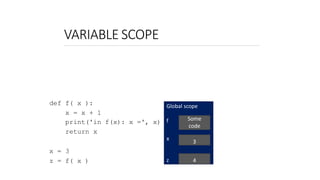














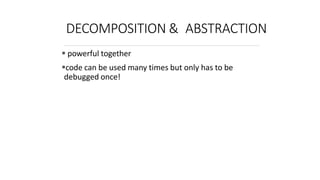
![TUPLES
an ordered sequence of elements, can mix element types
cannot change element values, immutable
represented with parentheses
te = ()
t = (2,"mit",3)
t[0]
(2,"mit",3) + (5,6)
evaluates to 2
evaluates to (2,"mit",3,5,6)
slice tuple, evaluates to ("mit",)
t[1:2]
t[1:3]
len(t)
slice tuple, evaluates to ("mit",3)
evaluates to 3
t[1] = 4 gives error, can’t modify object
6.0001 LECTURE5 72](https://image.slidesharecdn.com/introductiontopython-221004055743-c8cbd0da/85/Introduction-To-Python-pptx-72-320.jpg)

![MANIPULATING TUPLES
can iterate over tuples
def get_data(aTuple):
nums = ()
words = ()
for t in aTuple:
nums = nums + (t[0],)
if t[1] not in words:
words = words + (t[1],)
min_n = min(nums)
max_n = max(nums)
unique_words = len(words)
return (min_n, max_n, unique_words)
aTuple:(( ),( ),( ))
nums( )
words( ? ? ? )
if not already in words
i.e. unique strings from aTuple
6.0001 LECTURE5 74](https://image.slidesharecdn.com/introductiontopython-221004055743-c8cbd0da/85/Introduction-To-Python-pptx-74-320.jpg)
![LISTS
6.0001 LECTURE5 75
ordered sequence of information, accessible by index
a list is denoted by square brackets, []
a list contains elements
• usually homogeneous (ie, all integers)
• can contain mixed types (not common)
list elements can be changed so a list is mutable](https://image.slidesharecdn.com/introductiontopython-221004055743-c8cbd0da/85/Introduction-To-Python-pptx-75-320.jpg)
![INDICES AND ORDERING
a_list = []
L = [2, 'a', 4, [1,2]]
evaluates to 4
evaluates to 2
evaluates to 5
len(L)
L[0]
L[2]+1
L[3]
L[4]
i = 2
L[i-1]
evaluates to [1,2], another list!
gives an error
evaluates to ‘a’ since L[1]='a' above
6.0001 LECTURE5 76](https://image.slidesharecdn.com/introductiontopython-221004055743-c8cbd0da/85/Introduction-To-Python-pptx-76-320.jpg)
![CHANGING ELEMENTS
lists are mutable!
assigning to an element at an index changes the value
L = [2, 1, 3]
L[1] = 5
L is now [2, 5, 3], note this is the same object L
L
[2,5,3]
6.0001 LECTURE5 77](https://image.slidesharecdn.com/introductiontopython-221004055743-c8cbd0da/85/Introduction-To-Python-pptx-77-320.jpg)
![ITERATING OVER A LIST
compute the sum of elements of a list
common pattern, iterate over list elements
to len(L)-1
• range(n) goes from 0 to n-1
total = 0
for i in range(len(L)):
total += L[i]
print total
notice
• list elements are indexed 0
total = 0
for i in L:
total += i
print total
6.0001 LECTURE5 78](https://image.slidesharecdn.com/introductiontopython-221004055743-c8cbd0da/85/Introduction-To-Python-pptx-78-320.jpg)
![OPERATIONS ON LISTS - ADD
add elements to end of list with L.append(element)
mutates the list!
L = [2,1,3]
L.append(5) L is now [2,1,3,5]
what is the dot?
• lists are Python objects, everything in Python is an object
• objects have data
• objects have methods and functions
• access this information by object_name.do_something()
• will learn more about these later
6.0001 LECTURE5 79](https://image.slidesharecdn.com/introductiontopython-221004055743-c8cbd0da/85/Introduction-To-Python-pptx-79-320.jpg)
![OPERATIONS ON LISTS - ADD
6.0001 LECTURE5 80
to combine lists together use concatenation, + operator,
to give you a new list
mutate list with L.extend(some_list)
L1 = [2,1,3]
L2 = [4,5,6]
L3 = L1 + L2 L3 is [2,1,3,4,5,6]
L1, L2 unchanged
L1.extend([0,6]) mutated L1 to [2,1,3,0,6]](https://image.slidesharecdn.com/introductiontopython-221004055743-c8cbd0da/85/Introduction-To-Python-pptx-80-320.jpg)
![OPERATIONS ON LISTS-
REMOVE
delete element at a specific index with del(L[index])
remove element at end of list with L.pop(), returns the
removed element
remove a specific element with L.remove(element)
• looks for the element and removes it
• if element occurs multiple times, removes first occurrence
• if element not in list, gives an error
L = [2,1,3,6,3,7,0] # do below in order
L.remove(2) mutates L = [1,3,6,3,7,0]
L.remove(3) mutates L = [1,6,3,7,0]
del(L[1])
L.pop()
mutates L = [1,3,7,0]
returns 0 and mutates L = [1,3,7]
6.0001 LECTURE5 81](https://image.slidesharecdn.com/introductiontopython-221004055743-c8cbd0da/85/Introduction-To-Python-pptx-81-320.jpg)
![CONVERT LISTS TO STRINGS
AND BACK
6.0001 LECTURE5 82
convert string to list with list(s), returns a list with every
character from s an element in L
can use s.split(), to split a string on a character parameter,
splits on spaces if called without a parameter
use ''.join(L) to turn a list of characters into a string, can
give a character in quotes to add char between every element
s = "I<3 cs"
list(s)
s.split('<')
L = ['a','b','c']
''.join(L)
'_'.join(L)
s is a string
returns ['I','<','3',' ','c','s']
returns ['I', '3 cs']
L is a list
returns "abc"
returns "a_b_c"](https://image.slidesharecdn.com/introductiontopython-221004055743-c8cbd0da/85/Introduction-To-Python-pptx-82-320.jpg)
![OTHER LIST OPERATIONS
6.0001 LECTURE5 83
sort() and sorted()
reverse()
and many more!
https://docs.python.org/3/tutorial/datastructures.html
L=[9,6,0,3]
sorted(L)
L.sort()
L.reverse()
returns sorted list, does not mutate L
mutates L=[0,3,6,9]
mutates L=[9,6,3,0]](https://image.slidesharecdn.com/introductiontopython-221004055743-c8cbd0da/85/Introduction-To-Python-pptx-83-320.jpg)



![CLONING A LIST
create a new list and copy every element using
chill = cool[:]
6.0001 LECTURE5 87](https://image.slidesharecdn.com/introductiontopython-221004055743-c8cbd0da/85/Introduction-To-Python-pptx-87-320.jpg)


![MUTATION AND ITERATION
Try this in Python Tutor!
avoid mutating a list as you are iterating over it
def remove_dups(L1, L2):
for e in L1:
if e in L2:
L1.remove(e)
L1 = [1, 2, 3, 4]
L2 = [1, 2, 5, 6]
remove_dups(L1, L2)
L1 is [2,3,4] not [3,4] Why?
• Python uses an internal counter to keep track of index it is in the loop
• mutating changes the list length but Python doesn’t update the counter
• loop never sees element 2
def remove_dups(L1, L2):
L1_copy = L1[:]
for e in L1_copy:
if e in L2:
L1.remove(e)
6.0001 LECTURE5 90](https://image.slidesharecdn.com/introductiontopython-221004055743-c8cbd0da/85/Introduction-To-Python-pptx-90-320.jpg)








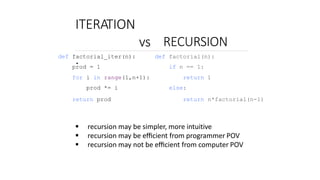
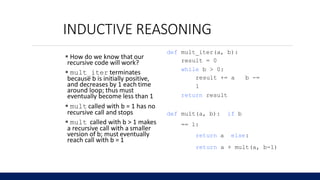

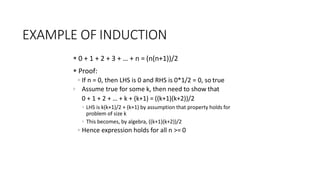




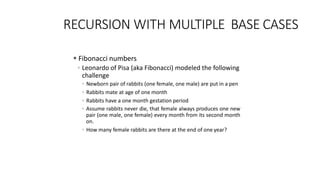








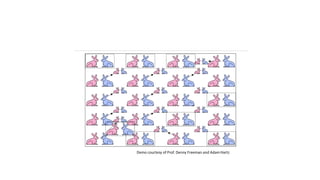




![RECURSION ON NON- NUMERICS
how to check if a string of characters is a palindrome, i.e.,
reads the same forwards and backwards
◦ “Able was I, ere I saw Elba” – attributed to Napoleon
◦ “Are we not drawn onward, we few, drawn onward to new era?” –
attributed to Anne Michaels
Image courtesy of wikipedia, in the public domain. By Larth_Rasnal (Own work) [GFDL (https://www.gnu.org/licenses/fdl-1.3.en.html) or
CC BY 3.0 (https://creativecommons.org/licenses/by/3.0)], via Wikimedia Commons.
12
1](https://image.slidesharecdn.com/introductiontopython-221004055743-c8cbd0da/85/Introduction-To-Python-pptx-121-320.jpg)


![def isPalindrome(s):
def toChars(s):
s = s.lower()
ans = ''
for c in s:
if c in
'abcdefghijklmnopqrstuvwxyz':
ans = ans + c
return ans
def isPal(s):
if len(s) <= 1:
return True
else:
return s[0] == s[-1] and isPal(s[1:-1])
return isPal(toChars(s))
12
4](https://image.slidesharecdn.com/introductiontopython-221004055743-c8cbd0da/85/Introduction-To-Python-pptx-124-320.jpg)


![HOW TO STORE
STUDENT INFO
so far, can store using separate lists for every info
names = ['Ana', 'John', 'Denise', 'Katy']
grade = ['B', 'A+', 'A', 'A']
course = [2.00, 6.0001, 20.002, 9.01]
a separate list for each item
each list must have the same length
info stored across lists at same index, each index refers to
info for a different person
12
7](https://image.slidesharecdn.com/introductiontopython-221004055743-c8cbd0da/85/Introduction-To-Python-pptx-127-320.jpg)
![HOW TO UPDATE/RETRIEVE STUDENT
INFO
12
8
• def get_grade(student, name_list, grade_list, course_list):
• i = name_list.index(student)
• grade = grade_list[i]
• course = course_list[i] return
(course, grade)
messy if have a lot of different info to keep track of
must maintain many lists and pass them as arguments
must always index using integers](https://image.slidesharecdn.com/introductiontopython-221004055743-c8cbd0da/85/Introduction-To-Python-pptx-128-320.jpg)


!['Ana' 'B'
'Denise' 'A'
'John' 'A+'
'Katy' 'A'
13
1
DICTIONARY LOOKUP
similar to indexing into a list
looks up the key
returns the value associated
with the key
if key isn’t found, get an error
grades = {'Ana':'B', 'John':'A+', 'Denise':'A', 'Katy':'A'}
grades['John']
grades['Sylvan']
evaluates to 'A+'
gives a KeyError](https://image.slidesharecdn.com/introductiontopython-221004055743-c8cbd0da/85/Introduction-To-Python-pptx-131-320.jpg)
![DICTIONAR
Y
OPERATION
S
'Ana' 'B'
'Denise' 'A'
'John' 'A+'
'Katy' 'A'
'Sylvan' 'A'
13
2
grades = {'Ana':'B', 'John':'A+', 'Denise':'A', 'Katy':'A'}
add an entry
grades['Sylvan'] = 'A'
test if key in dictionary
returns True
returns False
'John' in grades
'Daniel' in grades
delete entry
del(grades['Ana'])](https://image.slidesharecdn.com/introductiontopython-221004055743-c8cbd0da/85/Introduction-To-Python-pptx-132-320.jpg)
![DICTIONARY
OPERATIONS
'Ana' 'B'
'Denise' 'A'
'John' 'A+'
'Katy' 'A'
grades = {'Ana':'B', 'John':'A+', 'Denise':'A', 'Katy':'A'}
get an iterable that acts like a tuple of all keys
grades.keys() returns ['Denise','Katy','John','Ana']
get an iterable that acts like a tuple of all values
grades.values() returns ['A', 'A', 'A+', 'B']
13
3](https://image.slidesharecdn.com/introductiontopython-221004055743-c8cbd0da/85/Introduction-To-Python-pptx-133-320.jpg)
![DICTIONARY KEYS and VALUES
13
4
values
• any type (immutable and mutable)
• can be duplicates
• dictionary values can be lists, even other dictionaries!
keys
• must be unique
• immutable type (int, float, string, tuple,bool)
• actually need an object that is hashable, but think of as immutable as all
immutable types are hashable
• careful with float type as a key
no order to keys or values!
d = {4:{1:0}, (1,3):"twelve",
'const':[3.14,2.7,8.44]}](https://image.slidesharecdn.com/introductiontopython-221004055743-c8cbd0da/85/Introduction-To-Python-pptx-134-320.jpg)

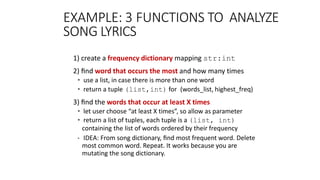
![CREATING A DICTIONARY
deflyrics_to_frequencies(lyrics):
myDict = {}
for word in lyrics:
if word in myDict:
myDict[word] += 1
else:
myDict[word] = 1
return myDict](https://image.slidesharecdn.com/introductiontopython-221004055743-c8cbd0da/85/Introduction-To-Python-pptx-137-320.jpg)
![USING THE DICTIONARY
def most_common_words(freqs):
values = freqs.values()
best = max(values)
words = []
for k in freqs:
if freqs[k] == best:
words.append(k)
return (words, best)](https://image.slidesharecdn.com/introductiontopython-221004055743-c8cbd0da/85/Introduction-To-Python-pptx-138-320.jpg)
![LEVERAGING DICTIONARY PROPERTIES
def words_often(freqs, minTimes):
result = []
done = False
while not done:
temp = most_common_words(freqs)
if temp[1] >= minTimes:
result.append(temp)
for w in temp[0]:
del(freqs[w])
else:
done = True
return result
print(words_often(beatles, 5))](https://image.slidesharecdn.com/introductiontopython-221004055743-c8cbd0da/85/Introduction-To-Python-pptx-139-320.jpg)


![FIBONACCI WITH A DICTIONARY
• def fib_efficient(n, d): if n
in d:
• return d[n] else:
• ans = fib_efficient(n-1, d) + fib_efficient(n-2, d) d[n] =
ans
• return ans
• d = {1:1, 2:2}
• print(fib_efficient(6, d))
do a lookup first in case already calculated the value](https://image.slidesharecdn.com/introductiontopython-221004055743-c8cbd0da/85/Introduction-To-Python-pptx-142-320.jpg)
